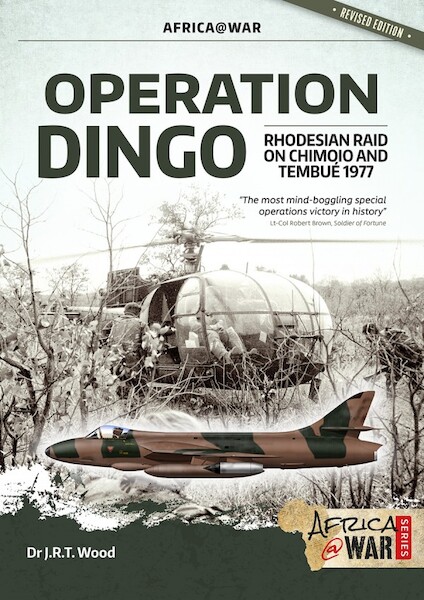
- aviationmegastore.com
- Ship to United States
Quick Search
Aviation Shop
categoriesPublic holidays
Amended or confirmed operating hours of the Luchtvaart Hobby Shop in Aalsmeerderbrug on the following dates:
Aviation Megastore website is available without limitations. Orders are processed during shop operating hours.
| Tu | 24 Dec. | Open 10-15 hrs |
| We | 25 Dec. | Closed: Christmas |
| Th | 26 Dec. | Closed: Christmas |
| Tu | 31 Dec. | Open 10-15 hrs |
| We | 1 Jan. | Closed: New Year's Day |
Operation Dingo: Rhodesian Raid on Chimoio and Tembué 1977 (revised edition)
Product code 9781912866816
€ 21.06
Series Africa @ War 35
Publisher/Brand Helion & Company
Author Dr J.R.T. Wood
Format a4
No. Pages 64
Version Soft cover
Language English
Category Books on aviation
Subcategory World Wars » War in Africa
Availability only 2 remaining
This product was added to our database on Monday 29 july 2019.
Your reliable Aviation Book Source since 1989
Also in this series:
Product description
Startling in its innovation and daringly suicidal, Operation Dingo was not only the Fireforce concept writ large but the prototype for all the major Rhodesian airborne attacks on the external bases of Rhodesian African nationalist insurgents in the neighbouring territories of Mozambique and Zambia until such operations ceased in late 1979.
Fireforce as a military concept is a 'vertical envelopment' of the enemy (first practised by SAS paratroopers in Mozambique in 1973), with the 20mm cannon being the principle weapon of attack, mounted in an Alouette III K-Car ('Killer car'), flown by the air force commander, with the army commander on board directing his ground troops deployed from G-Cars (Alouette III troop-carrying gunships and latterly Bell 'Hueys' in 1979) and parachuted from DC-3 Dakotas. In support would be propeller-driven ground-attack aircraft and on call would be Canberra bombers, Hawker Hunter and Vampire jets.
On 23 November 1977, the Rhodesian Air Force and 184 SAS and RLI paratroopers attacked 10,000 ZANLA cadres based at 'New Farm', Chimoio, 90 kilometres inside Mozambique. Two days later, the same force attacked 4,000 guerrillas at Tembué, another ZANLA base, over 200 kilometres inside Mozambique, north of Tete on the Zambezi River. Estimates of ZANLA losses vary wildly; however, a figure exceeding 6,000 casualties is realistic. The Rhodesians suffered two dead, eight wounded and lost one aircraft. It would produce the biggest SAS-led external battle of the Rhodesian bush war.
AFRICA@WAR SERIES
At any given time, there are at least half a dozen conflicts taking place in Africa, from civil strife and brutal insurgencies to full-blown conventional wars. Yet, apart from the grand campaigns and battles of colonial yesteryear—Omdurman, Isandlwana, Spioenkop et al—little is known outside the Dark Continent of the plethora of brushfire wars that occur with monotonous regularity. Following the Second World War, with the colonial powers—Britain in particular—looking to divest themselves of their burdensome empires, the 'winds of change', fuelled by the Cold War, swept through every nook and cranny of the continent. From Algeria to South Africa, from the Congo to Kenya, the continent literally erupted in conflict. Butchery and barbarism, under the guise of Black Nationalism, became bywords of African insurgencies; the tactics of terror, so espoused by Chairman Mao, one of the principal backers—in competition with Soviet imperialism—of African liberation movements, became standard operating procedure.
Africa—the continent that gave the world 'pseudo' counterterrorist operations as developed in Kenya to combat the Mau Mau, the Rhodesian Fireforce concept, radical innovations in vehicle mine-proofing, South African armour which fought the Cubans to a standstill at Cuito Cuanavale in the largest continental tank battle since Alamein, MiG and Mirage dogfights over the skies of Angola—is not all doom and gloom: it is as rich in its cultural diversity as it is in its martial traditions. Apart from a colourful array of liberation movements, mercenaries, brigands, pirates and terrorists, the cast includes such legendary units as the King's African Rifles, the Portuguese Flechettes, the French Foreign Legion, the Rhodesian Selous Scouts and SAS, and the South African Recces, 32 Battalion and Koevoet.
Africa@War, a ground-breaking series, studies Africa's post-1945 conflicts and military players in an informative and entertaining manner, examining some of the lesser known campaigns and shedding new light on some of the better known operations.
"The most mind-boggling special operations victory in history." Lt-Col Robert Brown, Soldier of Fortune magazine
"Africa@War is a ground-breaking series concept, studying Africa's conflicts and military players in an informative and entertaining manner, examining some of the lesser-known campaigns and shedding new light on some of the better-known operations … great models of what the combination of authors and publishers can produce by way of useable case studies for the market place in a concise illustrated format. They are recommended as professional military education references." Charles D. Melson, Chief Historian, U.S. Marine Corps
"Each of the books in this series is a well-documented and researched synopsis of the events that they are focused upon. They layouts and presentation are logical and of a very high quality ... As an introduction to this field of operation, this series is outstanding. A definite asset for those wishing to improve their knowledge and understanding of the development of successful, multi-faceted doctrine in the fight against insurgent/assymetric war."
Major Chris Buckham, Royal Canadian Air Force Journal
Shopping cart
Your shopping cart is empty.
Login
- aviationshopsupplies.com
- aviationmegatrade.com
© 1989–2024 Luchtvaart Hobby Shop B.V.









